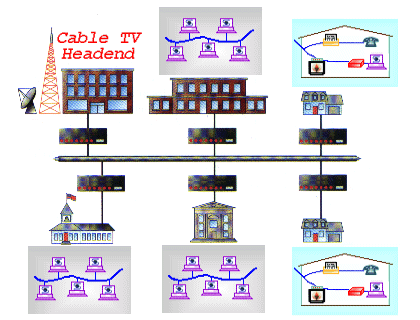
The basic structure of a cable system is a simple one.
There are five major parts to a cable system:
The coax cable connects to your cable modem, which in turn connects to an Ethernet card in your PC. The function of the cable modem is to connect broadband (i.e., the cable television network) to Ethernet. Once the Ethernet card has been installed, the TCP/IP software is installed on your PC.

It is a modem in the true sense of the word - it MOdulates and DEModulates signals. Cable modems can be part modem, part tuner, part encryption/decryption device, part bridge, part router, part NIC card, part SNMP agent, and part ethernet hub.
Typically, a cable modem sends and receives data in two slightly different fashions. In the downstream direction, the digital data is modulated and then placed on a typical 6 MHz television carrier, somewhere between 42MHz and 750 MHz. There are several modulation schemes, but the two most popular are QPSK (up to ~10 Mbps) and QAM64 (up to ~36 Mbps). This signal can be placed in a 6MHz channel adjacent to TV signals on either side without disturbing the cable television video signals. The upstream channel is more tricky. Typically, in a two-way activated cable network, the upstream (also known as the reverse path) is transmitted between 5 and 40 MHz. This tends to be a noisy environment, with lots of interference from HAM radio, CB radios and impulse noise from home appliances. Additionally, interference is easily introduced in the home, due to loose connectors, or poor cabling. Since cable networks are tree and branch networks, all this noise gets added together as the signals travel upstream, combining and increasing. Due to this problem, most manufacturers will be using QPSK or a similar modulation scheme in the upstream direction, because QPSK is more robust scheme than higher order modulation techniques in a noisy environment. The drawback is that QPSK is "slower" than QAM.
Receiving and Transmitting
Signals from various sources (including broadcast transmissions, satellite-delivered programming, and local television studio productions) are received and processed at the headend. Television signals are electromagnetic impulses or waves that take up space in the "frequency spectrum". They require some medium through which to travel, or propagate. Broadcast television transmissions travel through the air at various frequencies, and television signals carried on a cable system travel through a special type of cable. Signals can travel through metal wires such as coaxial cable. Each television signal travels on a different frequency inside the cable, and so coaxial cable acts as a self-contained spectrum. In effect, the cable industry creates its own spectrum -- and thereby enables households that cannot receive over-the-air transmissions to receive television. The cable operator receives a variety of different programs from satellite and broadcast signals, and re-transmits those signals through coaxial cable and/or optical fiber to customers' homes.
System Architecture
Generally, a large "trunk" cable carries the signals down through the center of town. The feeder cables, which are of smaller diameter, connect to the trunk cable and branch off into local neighborhoods. When a customer purchases cable services, the cable operator runs a smaller "drop" cable from the feeder cable directly into the customer's home, where it is attached to the television set. If the TV or VCR does not tune all the channels of interest because it is not "cable compatible," a converter is placed between the cable and the TV or VCR tuner. This system design, or "architecture" is known as a "tree and branch" design. The tree and branch architecture is the most efficient, economical method to transmit a package of multiple channels of programming from a headend to all customers.
Copyright 1996 http://www.cablemodems.com/